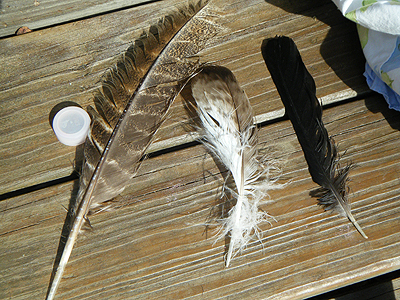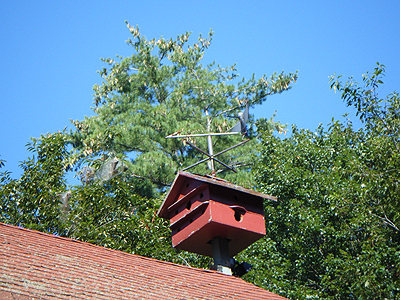New Hampshire Nature Notes
by Eric Orff
Birds of a feather shed their feathers together.
Wednesday 09/02/2009


The other day on one of my hour plus hikes into the hills nearby I briefly collected three feathers that were scattered along my path. Yes birds are shedding their feathers this time of year including their flight feathers. But for most birds, like the crow, turkey and hawk feathers I bent over to grasp, they only shed a couple of flight feathers at a time so they can continue to fly. Obviously a need if you are a predator like a hawk and need to fly to eat. It is often the crows or raven here locally that I will notice a pair of flight feathers missing from opposite wings from the same place in the wing so they can still fly smoothly. How magical nature is to have two feathers from opposite wings always shed at nearly the exact same time. Some birds like ducks and geese shed all their flight feathers at the same time in late June and must hide and seek security on water from ground predators.
We finally got the heat wave of the summer in the last couple of weeks. The temperature in June was 2 degrees below average and for July 3 degrees. So summer around here really didn't come until mid August. But my garden sure had a spurt of growth when it did arrive. So far I have canned 25 plus pints of bread and butter pickles, two dozen quarts of dill pickles plus 7 quarts of dilly beans. And I managed to freeze a supply of string beans to boot. My tomatoes are coming in strong now though they vines are not littered with them this year. So all my hard work all spring and summer is finally paying off this year.
I am seeing a bumper crop of pines cones in the 80 to 100 foot tall pines along the banks of the Suncook River between my house and the river. This probably means a future spike in red squirrel and mouse numbers around here. I read a study a few years ago done in Ontario where over time they were able to relate and essentially predict the American marten population a year or two out based on the production of cones. For when there is a great volume of cones produced the number of red squirrels would spike which would cause a spike in marten numbers a year or two later.
The Suncook River has run at near twice its normal volume all summer long. Although it did drop well down during the heat and dry spell of a couple weeks ago last Saturday's storm put over 3 inches of rain in my gauge and has the river back up again. Oh well the nights have turned much cooler and fall is but three weeks away. I'm still looking for the disappearing summer.
Next Note
2009-09-09
A once in a lifetime find of a baby spotted salamander and camp life is so sweet.
